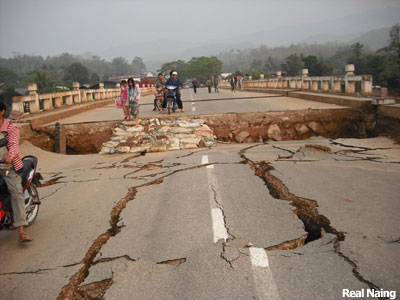(Feature) Thousands of devotees sat on the ground relaxed and quietly listening to a Dahmma talk in the early evening by Thaton Sayadaw (the visiting Abbot from the town of Thaton, Mon State), when suddenly the earth under them began to shake violently.

Then the nearby electricity transformer exploded, sending many people running and screaming in terror.
The pastoral scene was suddenly chaotic.
“Don’t run. Don’t run. If you run, it will be worse. Please, sit quietly,” one resident of Tachilek, who was in the Dahmma talk cried out to the frantic crowd.
“It’s shaking. It’s shaking. Please, help!” he soon shouted.
About 8pm on March 24, a 6.8 magnitiude earthquake struck Lao Mwe, 20 Kilometers north of Tachilek, eastern Shan State, near the Thai border.
Then, 20 aftershocks continued to shake the area after the main earthquake. Tachilek residents were afraid to remain in their houses. So, they spent the whole night on the street in front of the site of the Dahmma talk.
“I didn’t know what had happened. Tachilek was chaos,” a resident of San Sai Ward said about his experience.
However, the nearby villages of Kya Ku Ni, Mueng Leng Village and the town of Tarlay, were even closer to the center of the quake than Tachilek.
According to a resident of Tachilek, people from Kya Ku Ni village suffered even more devastation.
“Kya Ku Ni village is inhabited by Lahu people. Youth training was being held in the church for three days. On the night of the earthquake a closing ceremony for the three day training session was being held in the church. The church collapsed because of the earthquake.”
Over 20 people died in the church collapse and sixty people were injured. Later, 20 more died.

A Christian priest, who arrived the next day to help the earthquake victims in the village, spoke to the Network Media Group about the ordeal in an interview.
“I could say the whole village was damaged. It’s because the village is located on the slope of hill. When the earthquake began, the hill split and water came out from it. The village was completely flooded,” the priest said.
Only four of the 150 houses in Kya Ku Ni remained standing after the quake.
He said the earthquake lasted only minutes but the damage and problems created by the quake have lasted many months for the victims.
“It’s not easy to rebuild a house. And, the earthquake caused psychological damage to victims,” he added.
According to Tachilek residents, over 200 survivors from Kya Ku Ni fled to a relief center in nearby Maw Twi Village. Lahu militia provided needed relief supplies, including food and emergency shelters to earthquake victims.
Donors from Kengtung and Tachilek also tried to assist the villagers of Kya Ku Ni but were unable to because of communication problems and because roads were destroyed by the quake.
Dr. Tun Lwin, former Director of Burma’s Meteorological Department, told Network Media Group six earthquakes struck Burma in 2011. However, this earthquake was the strongest and it caused the most damage.
“Many strong earthquakes hit Burma in the past. This year, there were 3 in the Sagaing Region, one in Kachin State, one in Yamaethin Township in Mandalay Region, and the one in Tachilek, in eastern Shan State, which took many lives,” he said.
A bridge in Talay, located between Kengtung and Tachilek Road, was damaged. One end of the bridge was about 5 feet lower than other end. Huge fissures appeared in the streets, closing them to traffic.
World Vision, Unicef and local relief agencies distributed food, drinking water, plastic for shelters and other materials but these supplies were not enough to meet the needs of quake victims, according to the Christian priest.
Buddhist monks and Christian priests also donated needed materials and encouraged to earthquake victims.
Authorities attempted to fix the damaged bridge, road and collapsed buildings but were hampered by a lack of machinery and other materials.
Local residents hoped authorities would take one month to fully restore roads and bridges around Tachilek. However, they have still have not been able to do so.
“I am so surprised because it’s already three months since the earthquake hit Tachilek and victims have been facing difficulties. I do sympathize with the Kya Ku Ni villagers. It’s really difficult to rebuild a house because everything is expensive. I think it may take at least another two months to restore normalcy. Now the media coverage about earthquake victims is almost non-existent. I am so upset for them,” U Than Shwe, a resident of Tachilek, said.
The towns of Tarlay and Mueng Leng are on the Tachilek-Kengtung Road. Nine government office buildings, 390 houses, 31 religious buildings, 11 schools in the towns collapsed during the earthquake.
A government newspaper, issued on March 26, stated 73 people died and 125 people were injured by the quake. However, local people said nearly 300 people died.
According to statistics issued by the relief committee for earthquake victims, the cost of the damage will reach more than 3 billion Kyat (about US $ 3.6 million).
According to the Myanmar Post Journal, 18 strong earthquakes hit central Burma from 1906 to 2003.
The 6.8 magnitude quake which hit Bagan (the ancient city), central Burma, on 8 July 1975, was the worst and damaged historical and culture buildings.
According to Dr. Tun Lwin, the cities and towns of Taung-oo, Taung Twin Gyi, Bagan-Nyaung Oo, Kyauk-se, Pyin Oo Lwin, Shwe Bo, Wan Tho, Khamti, Harkhur, Myitkyina, Taung Gyi and Kum Lon, are all located in the earthquake zone. So, authorities opened seismic measuring stations in these towns.
Quakes measuring 6 or above on the Richter Scale, are considered to be strong earthquakes and can cause much damage.
“It’s really difficult to predict the exact time an earthquake will take place,” according to Dr. Tun Lwin. “Seismic activity is invisible to most people.”


